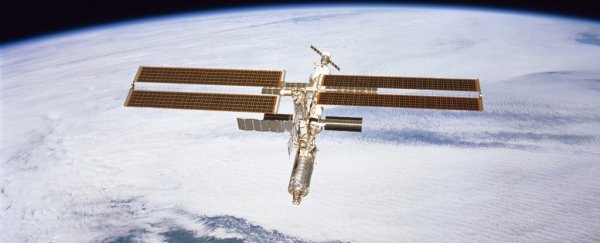It may only be 2 millimetres in diameter, but that tiny hole in Russia's Soyuz spacecraft docked on the International Space Station is creating a much bigger drama than depressurisation.
After Roscosmos head Dmitry Rogozin went on TV Monday to say the Russian investigation had determined that the hole was not a "manufacturing defect," NASA has issued yet another statement about the investigation.
The leak was discovered at the end of August when astronauts on board the space station were alerted that somehow they were slowly losing air pressure. They rapidly located the hole in the Soyuz MS-09 spacecraft, which is temporarily attached to the Rassvet module of the ISS, and patched it post-haste.
Then things started to get heated. Although it was initially thought that the hole was punched by a small meteorite, a photo released and then mysteriously deleted by NASA revealed unmistakeable drill tracks next to the hole.
ISS Leak summary:
— NSF - NASASpaceflight.com (@NASASpaceflight) September 3, 2018
First thought was MMOD strike.
Then NASA released pics. Lots of people: "Hmmm, doesn't look like MMOD". NASA deleted the photos.
Top Russian news site RIA NOVOSTI reported - via sources but apparently confirmed by Mr. Rogozin - it was a drill hole. pic.twitter.com/520kHK0TMc
So far, so good right? Until remarks made by Rogozin in early September sent the internet into a tizzy.
"It is a matter of honour for Energia Rocket and Space Corporation [the manufacturer of the Soyuz spacecraft] to find the one responsible for that, to find out whether it was an accidental defect or a deliberate spoilage and where it was done - either on Earth or in space," he was reported as saying.
That was enough for speculation to run wild, culminating in Russian newspaper Kommersant reporting that one of the NASA astronauts had drilled the hole - because he was sick and wanted to go home early in the spacecraft, rather than NASA paying for a rocket to come fetch him.
Obviously, that was totally unsubstantiated, just to be clear.
At this point, NASA and Roscosmos stepped in with a joint statement on September 13 that they were working together to launch an investigation into the provenance of the leak.
It is into this context that Rogozin's remarks earlier this week have landed. He mentioned on Russian telly that a first commission into the hole had delivered its report.
"It concluded that a manufacturing defect had been ruled out which is important to establish the truth," Rogozin is reported as saying. He added, "Where [the hole] was made will be established by a second commission, which is at work now."
Previously, an explanation had been reported by Russian news agency Ria Nostovi that someone at Energia had made a mistake during the manufacture of the spacecraft, and covered it up with glue and fabric. Rogozin's remark seems to mean that Roscosmos has now ruled this out.
But this doesn't mean, as some are reporting, that he believes the only possible other option is deliberate sabotage.
As NASA noted in a wrist-slapping statement released today, "Russian media recently reported that General Director Rogozin said the hole was not a manufacturing defect. Ruling out a manufacturing defect indicates that this is an isolated issue which does not categorically affect future production.
"This conclusion does not necessarily mean the hole was created intentionally or with mal-intent. NASA and Roscosmos are both investigating the incident to determine the cause."
That the hole was drilled once the spacecraft was in space seems the least likely conclusion. For one, no astronaut worth his or her salt would risk drill shavings floating around the ISS's microgravity environment, where it could get into and damage delicate instrumentation.
For two, it would actually be fairly difficult to do, as University of North Dakota aerospace engineer Pablo de Leon explained last month to Gizmodo.
"You need to push with enough force to penetrate both the fiberglass and the aluminum wall. It's mechanically difficult to do," he said. "You have no way to secure yourself with one hand in that particular space to make the hole with the second hand."
Other than the manufacturing facility in Samara, Russia, there are other terrestrial locations where the hole could have been drilled. En route from Samara to Baikonur, Kazakhstan, where the processing and launch facilities are located, for instance. Or at those facilities.
Both NASA astronauts and Roscosmos cosmonauts have vehemently denied that the crew had anything to do with the hole, or that they're working together in anything but harmony.
NASA noted in its statement that American astronaut Nick Hague and Russian cosmonaut Alexey Ovchinin will be launched to the space station together on October 11. At that time, NASA administrator Jim Bridenstine will be meeting with Rogozin.
And the investigation is ongoing.
"The International Space Station Program is tentatively planning a spacewalk in November to gather more information," NASA said.
